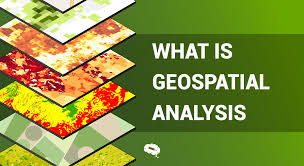Geospatial Analytics Market: An In-Depth Overview
Market Overview
Geospatial analytics is revolutionizing the way businesses and governments understand and interact with the world. By leveraging spatial data and sophisticated analytical techniques, geospatial analytics provides actionable insights across various sectors, including urban planning, agriculture, transportation, and defense. The market for geospatial analytics has been experiencing robust growth, driven by technological advancements, increased demand for location-based services, and the proliferation of smart city initiatives.
The Geospatial Analytics market size is projected to grow from USD 89.23 billion in 2024 to USD 209.81 billion by 2032. This growth is attributed to the rising adoption of artificial intelligence (AI), Internet of Things (IoT), and cloud computing in geospatial data collection and analysis.
Request To Free Sample of This Strategic Report - https://www.marketresearchfuture.com/sample_request/5801
Key Market Segments
The geospatial analytics market is segmented based on component, application, deployment mode, and end-use industry.
-
By Component:
- Software: GIS software, remote sensing, and analytics software.
- Services: Managed services and professional services.
-
By Application:
- Surveying: Land surveying and construction surveying.
- Telematics and Navigation: Fleet management and navigation systems.
- Disaster Risk Management: Natural disaster prediction and management.
- Climate Change Adaptation: Environmental monitoring and sustainability.
- Urban Planning: Smart city planning and infrastructure management.
- Others: Health and public safety, and retail management.
-
By Deployment Mode:
- On-premises
- Cloud-based
-
By End-Use Industry:
- Agriculture
- Government
- Defense
- Energy and Utilities
- Healthcare
- Others
Industry Latest News
The geospatial analytics industry is witnessing several notable developments:
-
Strategic Partnerships and Collaborations: Companies like ESRI and Microsoft have partnered to integrate geospatial analytics with cloud services, enhancing data accessibility and computational power.
-
Technological Innovations: The incorporation of AI and machine learning in geospatial data analysis is enabling more precise and predictive insights, particularly in areas such as climate change and disaster management.
-
Regulatory Developments: Governments worldwide are implementing policies to promote the use of geospatial data for urban planning, environmental monitoring, and public safety. For instance, the European Union's INSPIRE directive aims to create a unified geospatial data infrastructure across Europe.
-
Market Expansions: Key players are expanding their geographical footprint and service offerings to tap into emerging markets in Asia-Pacific and Latin America, where urbanization and infrastructure development are accelerating.
Geospatial Analytics Companies
Several companies dominate the geospatial analytics market, contributing to its growth and innovation:
-
ESRI (Environmental Systems Research Institute): A pioneer in GIS software, ESRI offers a comprehensive suite of geospatial analytics tools widely used across various industries.
-
Hexagon AB: Known for its advanced geospatial technologies, Hexagon provides solutions for surveying, mapping, and location-based services.
-
Trimble Inc.: Trimble's geospatial solutions are pivotal in agriculture, construction, and transportation, providing precise location data and analytics.
-
Pitney Bowes Inc.: Specializing in location intelligence, Pitney Bowes offers software and services that enhance decision-making through geospatial data.
-
Google LLC: Through its Google Earth Engine and other geospatial tools, Google facilitates large-scale analysis and visualization of geospatial data.
-
SAP SE: Integrating geospatial analytics with enterprise software, SAP helps businesses leverage location data for operational efficiency and strategic planning.
Market Drivers
The growth of the geospatial analytics market is fueled by several key drivers:
-
Technological Advancements: Innovations in AI, machine learning, and big data analytics are enhancing the capabilities of geospatial analytics, enabling more sophisticated and accurate insights.
-
Increasing Demand for Location-Based Services: The proliferation of smartphones and IoT devices has spurred demand for location-based services in navigation, marketing, and social media.
-
Smart City Initiatives: Governments worldwide are investing in smart city projects that rely heavily on geospatial analytics for urban planning, infrastructure management, and public safety.
-
Climate Change and Environmental Monitoring: The growing need to monitor and respond to environmental changes is driving the adoption of geospatial analytics in climate science, agriculture, and disaster management.
-
Regulatory Support: Government regulations promoting the use of geospatial data for various applications, including defense, public safety, and urban planning, are bolstering market growth.
Ask for Customization - https://www.marketresearchfuture.com/ask_for_customize/5801
Regional Insights
The geospatial analytics market exhibits varied growth patterns across different regions:
-
North America: Dominating the market, North America benefits from the presence of major technology companies and extensive government initiatives promoting geospatial data use. The U.S. Department of Defense and NASA are significant consumers of geospatial analytics.
-
Europe: The European market is driven by regulatory frameworks like the INSPIRE directive and substantial investments in smart city projects. Countries like Germany, France, and the UK are at the forefront of adopting geospatial technologies.
-
Asia-Pacific: This region is expected to witness the highest growth rate due to rapid urbanization, infrastructure development, and increasing adoption of geospatial technologies in countries like China, India, and Japan.
-
Latin America: Growth in this region is propelled by investments in agriculture and urban planning, particularly in Brazil and Mexico. Government initiatives to improve public safety and disaster management also contribute to market expansion.
-
Middle East and Africa: The market in this region is growing steadily, driven by investments in infrastructure development and the oil and gas industry. Countries like the UAE and South Africa are notable markets for geospatial analytics.
Conclusion
The geospatial analytics market is poised for significant growth, driven by technological advancements, increasing demand for location-based services, and supportive regulatory frameworks. As industries and governments continue to recognize the value of spatial data in decision-making, the adoption of geospatial analytics is set to expand further, unlocking new opportunities and transforming various sectors globally. Companies operating in this space are well-positioned to capitalize on these trends by continuing to innovate and expand their offerings to meet the evolving needs of the market.



